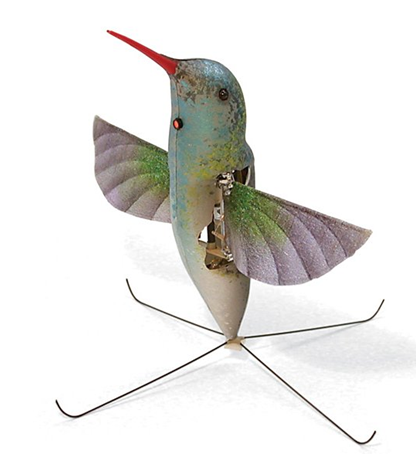UAV or UAS? The Future of Remote Sensing
Anonym
When thinking about imagery, I am enchanted on a daily basis about how we can utilize technology to capture information we cannot "see". We can then manipulate the information in such a way that something otherwise “invisible” actually becomes obvious. Let’s take a minute to have some fun looking at the obvious. Do these icons look familiar?

Yes, it is a computer mouse that actually looks like a mouse and Kramer’s infamous coffee table book about coffee tables. So what on earth – or more accurately, what in the sky, has sparked my recent inquisition? Checkout Aerovironment’s Nano Hummingbird UAV that looks like (and even moves like) an actual hummingbird:

Image recently published in Earth Imaging Journal | Aerovironment site
This month alone there were three articles published in Earth Imaging Journal (EIJ) that touched on various topics related to unmanned aircraft. In fact, according to the article by Michael Hutt from the USGS (USGS UAS Program Does More with Less) the unmanned aircraft integration into the national airspace system (NAS) will create more than 70,000 new US jobs and grow the market segment to $13.6 billion within three years of integration. Recent influx of UAV applications in the news, industry journals, and even from my customers, supports this growth theory as do the rapid advances in technical capabilities of these small ‘birds’.
While we are on the cusp of a new era in remote sensing technology, the terminology is still catching up and has yet to completely work itself out. If you Google UAV vs. UAS you will quickly find that there has been a great debate about which term is “correct” and how these acronyms may become distinguished from one another in the near future.
UAV or UAS?
What is most similar between the two and also what distinguishes these aircraft from remote control planes is that these aircraft have pilots at a ground station in continuous control of the vehicle at all times. This is true whether the aircraft can be seen from the ground or not. So what distinguishing features separate a UAV from a UAS?
According to the Association for Unmanned Aerial Vehicle Systems International (AUVSI), a UAV incorporates “…lightweight airframes, advanced propulsion systems, secure data links, and high technology control systems and payloads.”
As the industry moves forward the platform itself is rapidly becoming distinguished from the advanced aspects of deployment and compliance requirements with NAS regulations. Compliance will be greatly dependent upon the ability to implement safety regulations. Tasks such as radio communication, capture systems, and even implementation of sense-and-avoid technologies will be controlled at these ground stations. Thus the “S” in UAS encompasses the system in its entirety.
I am personally excited to follow and learn how the UAS industry continues to evolve and look forward to the opportunity to work on more UAS applications. Will you be using an unmanned aircraft in the future?